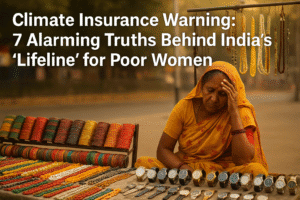Climate Insurance Warning: 7 Alarming Truths Behind India’s “Lifeline” for Poor Women
Rising heat devastates India’s informal women workers—street vendors, waste pickers, and home-based laborers—melting wares, slashing incomes, and triggering health crises. A new parametric microinsurance, pioneered by organizations like SEWA, offers relief: it pays out automatically when local temperature thresholds are met, bypassing complex assessments. After a flawed 2023 pilot, redesigned 2024 triggers (using hyper-local data and guaranteed cash layers) reached 46,339 women across 17 districts. While crucial immediate aid, critics warn it risks normalizing government inaction. Climate justice advocate Harjeet Singh argues insurance can’t replace systemic solutions—like social safety nets, urban cooling infrastructure, and wage protections—needed to address the root causes of vulnerability as heatwaves intensify.

Deviben Dhaundhaliya’s colourful artificial jewellery – the bangles, necklaces, and knock-off designer watches that line her iron-frame street stall in Ahmedabad – aren’t just her livelihood; they’re fragile sentinels against an increasingly hostile climate. As temperatures soar beyond 45°C (113°F), her wares melt and discolour under the relentless Indian sun. “The anxiety starts every summer,” she confesses, her voice echoing the dread felt by millions of India’s informal women workers. “Our income plummets. Sickness stalks us.”
Deviben’s story isn’t isolated. It’s the brutal reality for an estimated 90% of India’s female workforce toiling in the informal sector – street vendors like Deviben, waste recyclers like Hansaben Ahir (who battles heat cramps and urinary infections on scorching pavements), home-based workers, and construction labourers. For them, extreme heat isn’t an abstract climate statistic; it’s a daily assault on their health and their ability to earn the meagre 150-450 Rupees ($1.74-$5.22) that sustains their families. Missed workdays mean empty stomachs and mounting debts.
The Scorching Statistics: Asia is warming nearly twice as fast as the global average. The World Meteorological Organization confirms 2024 as one of Asia’s hottest years on record. Swiss Re estimates extreme heat causes nearly half a million global deaths annually and drains 1.7% of global GDP through lost labour hours. India’s informal women workers, lacking safety nets, bear a disproportionate brunt.
Enter the “Parametric” Lifeline: In this crucible, a novel form of financial protection is emerging: parametric microinsurance. Unlike traditional insurance requiring lengthy loss assessments, parametric policies pay out automatically when a pre-defined trigger (like consecutive days above a specific temperature) is met via satellite or weather station data. Speed and simplicity are its core promises for vulnerable daily wagers.
Pioneered by the Self-Employed Women’s Association (SEWA), a union representing 2.9 million informal women workers, this insurance aims to blunt heat’s economic impact. Sahil Hebbar, SEWA’s insurance coordinator (and a physician), details the damage: “Livelihoods plummet 30-50% due to heat – reduced hours, spoiled goods, lost customers, illness.”
Trial, Error, and Payouts: The journey hasn’t been smooth. A 2023 pilot, relying solely on satellite-measured highs above 45-46°C, failed to trigger payouts despite it being India’s second-hottest year on record. The reason? A critical disconnect. Satellite data didn’t reflect the punishing ground-level conditions workers endured, nor account for the deadly combination of heat and humidity (wet-bulb effect) or harmful high nighttime temperatures.
Learning swiftly, SEWA and reinsurer Swiss Re redesigned the 2024 scheme:
- Hyper-Local Triggers: Using granular historical temperature data for specific districts.
- Cash Assistance Layer: Guaranteed support (₹400/~$4.64) triggered across all districts, regardless of extreme heat thresholds.
- Scaled Up: Covering 50,000 women across 22 districts in Gujarat, Rajasthan, and Maharashtra.
The result? Triggers activated in 17 districts. 46,339 women received payouts ranging from ₹151 to ₹1651 ($1.75-$19). While modest, this cash provides crucial breathing room – covering medical bills for heatstroke or hypertension, or bridging income gaps when work is impossible. The Gujarat-based Mahila Housing Trust has also launched similar heat insurance for urban poor communities. Even the state government of Nagaland has adopted parametric insurance for monsoon disasters.
The Critical Question: Lifeline or Let-Down? While the 2024 success marks progress, profound concerns linger. Climate activist Harjeet Singh delivers a stark warning:
“Parametric insurance is not a panacea; it’s potentially dangerous. It risks becoming an excuse for governments to abandon their fundamental duty to protect citizens.”
Singh, a leading voice in the UN Loss and Damage movement, argues compellingly:
- False Security: Insurance becomes unaffordable or unavailable as climate risks escalate (already seen in developed nations). Relying on it long-term is unsustainable.
- Inadequate Payouts: Fixed payouts based on triggers, not actual losses, often fall far short of real recovery needs.
- Abdication of Responsibility: It shifts focus from systemic solutions governments must provide: robust social safety nets (cash transfers, subsidised food), guaranteed wage employment during heatwaves, investments in shade, cooling centres, accessible healthcare, and worker protections.
The Human Verdict: For Deviben and Hansaben, the insurance payout is a tangible, immediate relief – a rare shield against forces far beyond their control. “It helps with the medical expenses,” Deviben acknowledges. But it doesn’t stop her bangles from melting. It doesn’t create shaded marketplaces. It doesn’t mandate paid heat leave.
The Path Forward: Parametric microinsurance represents an innovative, necessary temporary buffer for those on the climate frontlines. Its success in 2024 proves the model can be refined and localized. However, celebrating it as the solution is perilous. True resilience demands:
- Government Accountability: Enforcing heat action plans, investing in urban cooling infrastructure, and expanding universal social protection.
- Scaling Adaptation: Ensuring insurance complements, not replaces, essential adaptation measures like access to water, shade, and healthcare.
- Global Climate Justice: Recognizing that the women bearing the cruelest costs of heatwaves contributed least to causing them.
Insurance can buy time and reduce immediate suffering. But only systemic change, driven by unwavering political will and a commitment to climate justice, can offer India’s poorest women – and billions like them globally – genuine protection from the furnace of our warming world. Their melting wares are a stark symbol; the response must be more than just a financial band-aid.
You must be logged in to post a comment.